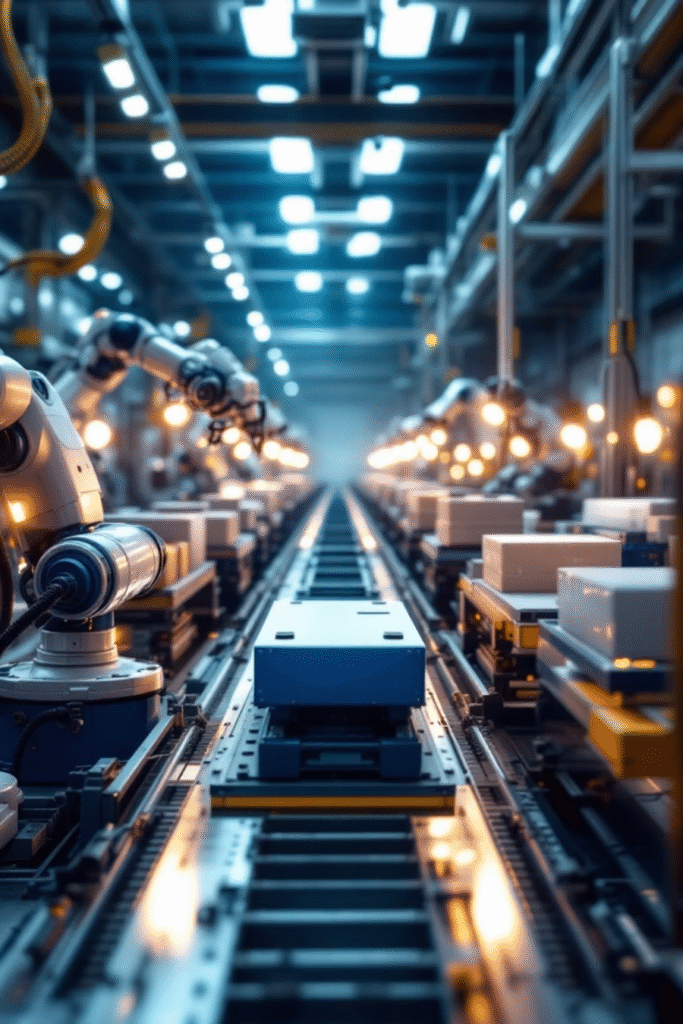
Brief description
Virtual commissioning involves testing, debugging and optimising complex production equipment or entire production lines using a fully digital model, before any real components are assembled. In other words, engineers can virtually “launch” a factory on a computer to identify and resolve issues in advance, thereby avoiding costly errors and delays in the real world.
Benefits for the customer

Early error detection
Logical errors in PLC programs, problems in the sequence of operations, possible robot collisions and incorrect sensor operation are detected and corrected at the design stage. Consequently, the risk of rework and downtime, which typically occurs during classical commissioning, is minimised.
Process optimisation
In a virtual environment, various operating scenarios can be experimented with, and equipment parameters, conveyor speeds and robot trajectories can be changed. This helps to identify the most efficient modes, shorten cycle times and increase line productivity.
Reduction of commissioning time
Since the main debugging takes place virtually, the actual commissioning of the line is significantly faster. Installation and commissioning crews receive verified solutions, reducing the time spent on-site making adjustments.
Risk reduction at start-up
Testing in digital format eliminates the risk of damaging expensive equipment or injuring personnel during commissioning. All extreme situations (e.g. emergency stops or equipment failure) can be worked through virtually without consequence.
Personnel training
Operators and engineers can familiarise themselves with the new production process in advance. Using simulators and VR models, they can learn to operate the system and work through normal and abnormal scenarios in a safe environment. This improves their qualifications and confidence before the real start-up.
Painless changes
If changes need to be made to an operating shop, such as adding a new robot or reconfiguring the technological sequence, these are first tested in the virtual model. This ensures that the modernisation will not result in failures in practice.
Virtual Commissioning

Role of the team
The technical team creates a virtual copy of the production line, including 3D models of all the machines, robots, conveyors and sensors. Specialists then connect the actual controller software to this virtual model: PLCs, robot control systems, and so on, so that the programs ‘think’ they are controlling real equipment. During the virtual start-up stage, engineers operate the line in various modes and conduct a thorough analysis of the system’s behaviour. The team identifies errors in the program logic, optimises the motion trajectories of the mechanisms and configures how all the components interact. By working closely with the plant’s engineers, the group of specialists ensures that the system operates without failures and meets the specified performance and safety indicators even before physical installation.

Implementation in practice
- Creating the digital model: Engineers build an accurate, three-dimensional model of all line components, from equipment and robotics to conveyors and workpieces. This model incorporates the kinematics of the mechanisms, sensor logic and other characteristics.
- Connecting controller software: Real control programs (PLC, robots, etc.) are connected to the virtual equipment. All signals from these controllers are redirected into the digital model so that the programs can be executed as if the production line already existed in physical form.
- Test run and debugging: After launching the virtual production line, engineers observe how it operates. Special visualisation tools show the movement of parts, sensor readings and drive operation. The team systematically checks each situation, including normal cycles, emergency scenarios and transient modes. Logical errors identified in the programs are eliminated, robot trajectories are adjusted to avoid collisions and equipment parameters are configured for optimal performance. After multiple virtual iterations, a calibrated, debugged model is obtained. Only then is the actual line installed and started up, but this process is much faster since the main issues have already been resolved digitally.
